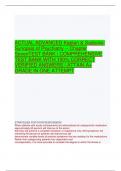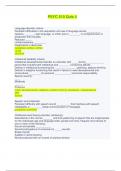ACTUAL ADVANCED Kaplan & Sadocks:
Synopsis of Psychiatry -- Chapter
SevenTEST BANK | COMPREHENSIVE
TEST BANK WITH 100% CORRECT
VERIFIED ANSWERS | ATTAIN A+
GRADE IN ONE ATTEMPT
STRATEGIES FOR POOR RESPONDERS
When patients with acute schizophrenia are administered an antipsychotic medication,
approximately 60 percent will improve to the extent
that they will achieve a complete remission or experience only mild symptoms; the
remaining 40 percent of patients will improve but still
demonstrate variable levels of positive symptoms that are resistant to the medications.
Rather than categorizing patients into responders and
nonresponders, it is more accurate to consider the degree to which the illness is
,improved by medication. Some resistant patients are so
severely ill that they require chronic institutionalization. Others respond to an
antipsychotic with substantial suppression of their psychotic
symptoms but demonstrate persistent symptoms, such as hallucinations or delusions.
MANAGING SIDE EFFECTS
Clinicians have a number of alternatives for treating extrapyramidal side eects. These
include reducing the dose of the antipsychotic (which
is most commonly a DRA), adding an anti-Parkinson medication, and changing the
patient to an SDA that is less likely to cause
extrapyramidal side efects. The most eective anti-Parkinson medications are the
anticholinergic anti-Parkinson drugs. However, these
medications have their own side efects, including dry mouth; constipation; blurred
vision; and, often, memory loss. Also, these medications
are often only partially efective, leaving patients with substantial amounts of lingering
extrapyramidal side efects. Centrally acting β-blockers, such as propranolol, are also
often efective for treating akathisia. Most patients respond to dosages between 30 and
90 mg perday.
Tardive Dyskinesia
About 20 to 30 percent of patients on long-term treatment with a conventional DRA will
exhibit symptoms of tardive dyskinesia. About 3 to
5 percent of young patients receiving a DRA develop tardive dyskinesia each year. The
risk in elderly patients is much higher. Although
seriously disabling dyskinesia is uncommon, it can aect walking, breathing, eating, and
talking when it occurs. Individuals who are more
sensitive to acute extrapyramidal side eects appear to be more vulnerable to developing
tardive dyskinesia. Patients with comorbid
cognitive or mood disorders may also be more vulnerable to tardive dyskinesia than
those with only schizophrenia.
Other Side Effects
Sedation and postural hypotension can be important side eects for patients who are
being treated with low-potency DRAs, such as
perphenazine. These eects are often most severe during the initial dosing with these
medications. As a result, patients treated with these
medications—particularly clozapine—may require weeks to reach a therapeutic dose.
Although most patients develop tolerance to sedation
and postural hypotension, sedation may continue to be a problem. In these patients,
daytime drowsiness may interfere with a patient's
attempts to return to community life.
All DRAs, as well as SDAs, elevate prolactin levels, which can result in galactorrhea
and irregular menses. Long-term elevations in
prolactin and the resultant suppression in gonadotropin-releasing hormone can cause
suppression in gonadal hormones. These, in turn, may
have eects on libido and sexual functioning. There is also concern that elevated
prolactin may cause decreases in bone density and lead to
osteoporosis. The concerns about hyperprolactinemia, sexual functioning, and bone
density are based on experiences with prolactin
,elevations related to tumors and other causes. It is unclear if these risks are also
associated with the lower elevations that occur with
prolactin-elevating drugs.
Health Monitoring in Patients Receiving Antipsychotics
Because of the eects of the SDAs on insulin metabolism, psychiatrists should monitor a
number of health indicators, including BMI, fasting
blood glucose, and lipid proles. Patients should be weighed and their BMIs calculated
for every visit for 6 months after a medication
change.
Side Effects of Clozapine
Clozapine has a number of side eects that make it a dicult drug to administer. The most
serious is a risk of agranulocytosis. This
potentially fatal condition occurs in approximately 0.3 percent of patients treated with
clozapine during the rst year of exposure.
Subsequently, the risk is substantially lower. As a result, patients who receive clozapine
in the United States are required to be in a program
of weekly blood monitoring for the rst 6 months and biweekly monitoring for the next 6
months. After 1 year of treatment without
hematological problems, monitoring can be performed monthly.
Clozapine is also associated with a higher risk of seizures than other antipsychotics.
The risk reaches nearly 5 percent at doses of more
than 600 mg. Patients who develop seizures with clozapine can usually be managed by
reducing the dose and adding an anticonvulsant,
usually valproate (Depakene). Myocarditis has been reported to occur in approximately
ve patients per 100,000 patient-years. Other side
effects with clozapine include hypersalivation, sedation, tachycardia, weight gain,
diabetes, fever, and postural hypotension.
OTHER BIOLOGICAL THERAPIES
Electroconvulsive therapy (ECT) has been studied in both acute and chronic
schizophrenia. Studies in recent-onset patients indicate that ECT
is about as eective as antipsychotic medications and more eective than psychotherapy.
Other studies suggest that supplementing
antipsychotic medications with ECT is more eective than antipsychotic medications
alone. Antipsychotic medications should be
administered during and after ECT treatment. Although psychosurgery is no longer
considered an appropriate treatment, it is practiced on a
limited experimental basis for severe, intractable cases.
PSYCHOSOCIAL THERAPIES
Psychosocial therapies include a variety of methods to increase social abilities, self-
suciency, practical skills, and interpersonal
communication in schizophrenia patients. The goal is to enable persons who are
severely ill to develop social and vocational skills for
independent living. Such treatment is carried out at many sites, including hospitals,
outpatient clinics, mental health centers, day hospitals,
and home or social clubs.
Social Skills Training
, Social skills training is sometimes referred to as behavioral skills therapy. Along with
pharmacological therapy, this therapy can be directly
supportive and useful to the patient. In addition to the psychotic symptoms seen in
patients with schizophrenia, other noticeable symptoms
involve the way the person relates to others, including poor eye contact, unusual delays
in response, odd facial expressions, lack of
spontaneity in social situations, and inaccurate perception or lack of perception of
emotions in other people. Behavioral skills training
addresses these behaviors through the use of videotapes of others and of the patient,
role playing in therapy, and homework assignments for the specific skills being
practiced. Social skills training has been shown to reduce relapse rates as measured by
the need for hospitalization.
Family-Oriented Therapies
benet from a brief but intensive (as often as daily) course of family therapy. The therapy
should focus on the immediate situation and
should include identifying and avoiding potentially troublesome situations. When
problems do emerge with the patient in the family, the
aim of the therapy should be to resolve the problem quickly. In wanting to help, family
members often encourage a relative with schizophrenia to resume regular activities too
quickly, both from
ignorance about the disorder and from denial of its severity. Without being overly
discouraging, therapists must help both the family and the
patient understand and learn about schizophrenia and must encourage discussion of
the psychotic episode and the events leading up to it.
National Alliance on Mental Illness (NAMI).
The NAMI and similar organizations offer support groups for family members and
friends of patients who are mentally ill and for patients themselves. These organizations
offer emotional and practical advice about
obtaining care in the sometimes complex health care delivery system and are useful
sources to which to refer family members. NAMI has also waged a campaign to
destigmatize mental illness and to increase government awareness of the needs and
rights of persons who are
mentally ill and their families
Case Management
Because a variety of professionals with specialized skills, such as psychiatrists, social
workers, and occupational therapists, among others, are
involved in a treatment program, it is helpful to have one person aware of all the forces
acting on the patient. The case manager ensures
that their eorts are coordinated and that the patient keeps appointments and complies
with treatment plans; the case manager may make
home visits and even accompany the patient to work. The success of the program
depends on the educational background, training, and
competence of the individual case manager, which vary. Case managers often have too
many cases to manage eectively. The ultimate
benefits of the program have yet to be demonstrated.
Assertive Community Treatment





